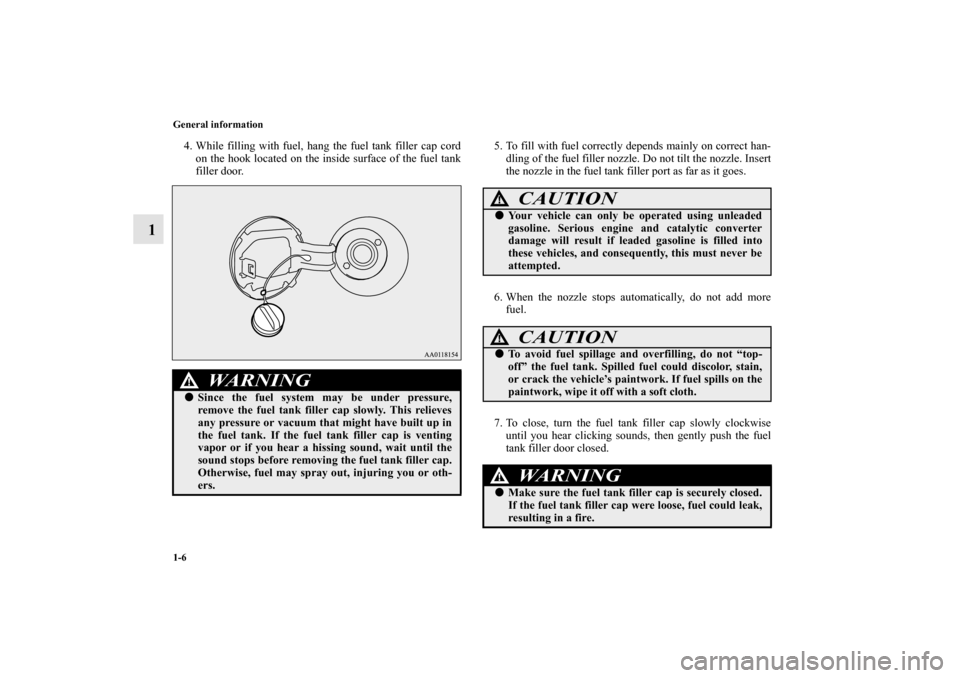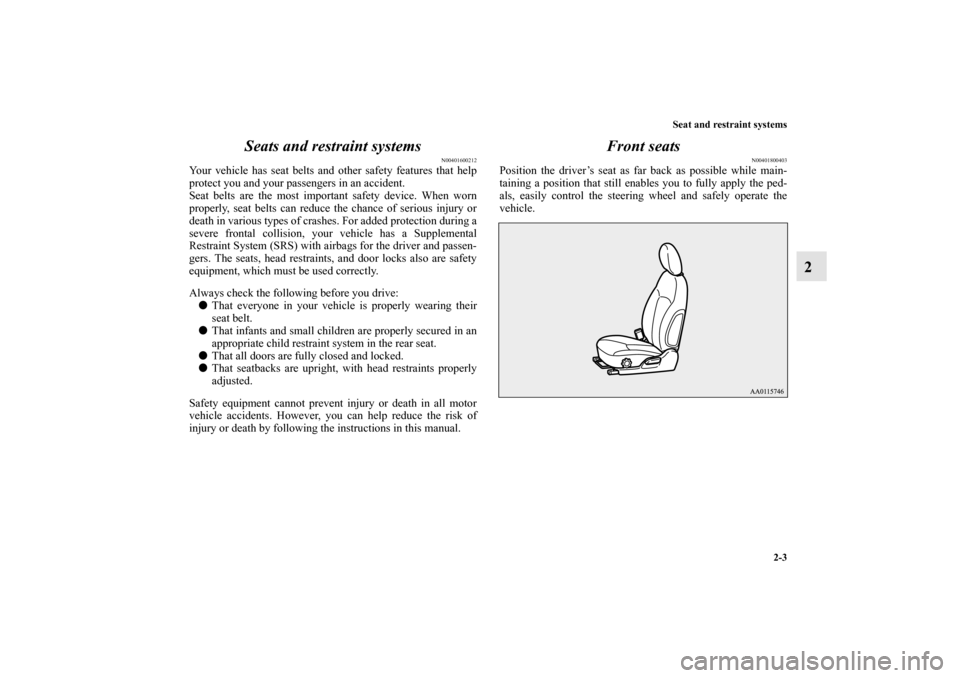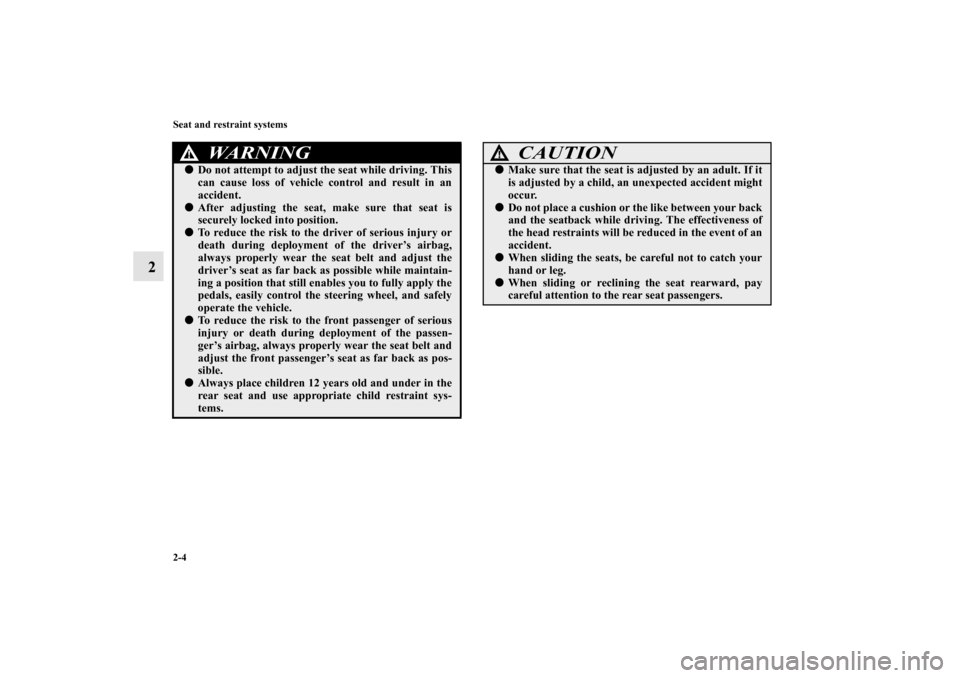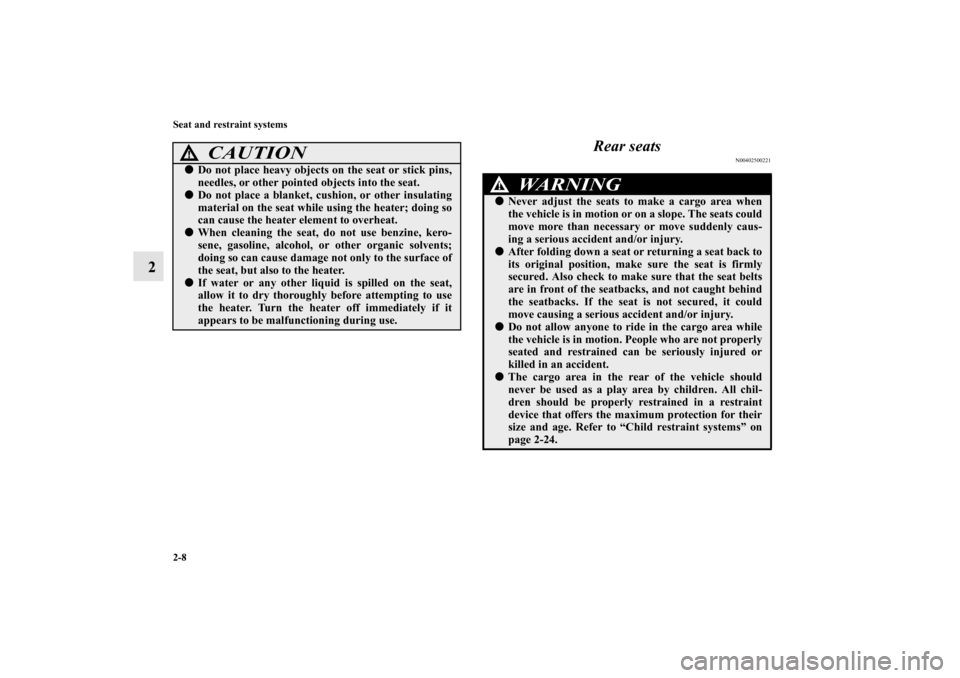Page 6 of 460
Overview
Outside
N00100601365
Antenna P.5-64Power window (if so equipped) P.3-43
Outside rearview mirrors P.3-52
Fuel ta nk filler P.1-4
F.A.S.T.-key (Free-hand
Advanced Security Transmitter)
( if so e q u ipp ed) P.3 -13
Keyless entry sysetm (if
soe qu ip ped) P.3- 8
Locking and unlocking P.3-35
Side turn signal lights
P.3-118, 7-44
Front side- marker lights
P.3-114, 7-44, 7-47
Headlights/Daytime running lights (if so equipped)
P.3-114, 7-44, 7-46
Parking lights
P.3-114, 7-44, 7-49
Front turn signal lights
P.3-118, 7-44, 7-48
Front fog lights (if so
equipped)
P.3-120, 7-44, 7-50 Engine hood P.7-5
Windshield wipers P.3-121
BK0162600US.book 5
\bM\bo\b+ 2013年3月22日 金曜日 午後2時41\f
Page 22 of 460

1-6 General information
1
4. While filling with fuel, hang the fuel tank filler cap cord
on the hook located on the inside surface of the fuel tank
filler door.5. To fill with fuel correctly depends mainly on correct han-
dling of the fuel filler nozzle. Do not tilt the nozzle. Insert
the nozzle in the fuel tank filler port as far as it goes.
6. When the nozzle stops automatically, do not add more
fuel.
7. To close, turn the fuel tank filler cap slowly clockwise
until you hear clicking sounds, then gently push the fuel
tank filler door closed.
WA R N I N G
!�Since the fuel system may be under pressure,
remove the fuel tank filler cap slowly. This relieves
any pressure or vacuum that might have built up in
the fuel tank. If the fuel tank filler cap is venting
vapor or if you hear a hissing sound, wait until the
sound stops before removing the fuel tank filler cap.
Otherwise, fuel may spray out, injuring you or oth-
ers.
CAUTION
!�Your vehicle can only be operated using unleaded
gasoline. Serious engine and catalytic converter
damage will result if leaded gasoline is filled into
these vehicles, and consequently, this must never be
attempted.
CAUTION
!�To avoid fuel spillage and overfilling, do not “top-
off” the fuel tank. Spilled fuel could discolor, stain,
or crack the vehicle’s paintwork. If fuel spills on the
paintwork, wipe it off with a soft cloth.
WA R N I N G
!�Make sure the fuel tank filler cap is securely closed.
If the fuel tank filler cap were loose, fuel could leak,
resulting in a fire.
BK0162600US.book 6 ページ 2013年3月22日 金曜日 午後2時41分
Page 29 of 460

Seat and restraint systems
2-3
2 Seats and restraint systems
N00401600212
Your vehicle has seat belts and other safety features that help
protect you and your passengers in an accident.
Seat belts are the most important safety device. When worn
properly, seat belts can reduce the chance of serious injury or
death in various types of crashes. For added protection during a
severe frontal collision, your vehicle has a Supplemental
Restraint System (SRS) with airbags for the driver and passen-
gers. The seats, head restraints, and door locks also are safety
equipment, which must be used correctly.
Always check the following before you drive:
�That everyone in your vehicle is properly wearing their
seat belt.
�That infants and small children are properly secured in an
appropriate child restraint system in the rear seat.
�That all doors are fully closed and locked.
�That seatbacks are upright, with head restraints properly
adjusted.
Safety equipment cannot prevent injury or death in all motor
vehicle accidents. However, you can help reduce the risk of
injury or death by following the instructions in this manual.
Front seats
N00401800403
Position the driver’s seat as far back as possible while main-
taining a position that still enables you to fully apply the ped-
als, easily control the steering wheel and safely operate the
vehicle.
BK0162600US.book 3 ページ 2013年3月22日 金曜日 午後2時41分
Page 30 of 460

2-4 Seat and restraint systems
2
WA R N I N G
!�Do not attempt to adjust the seat while driving. This
can cause loss of vehicle control and result in an
accident.�After adjusting the seat, make sure that seat is
securely locked into position.�To reduce the risk to the driver of serious injury or
death during deployment of the driver’s airbag,
always properly wear the seat belt and adjust the
driver’s seat as far back as possible while maintain-
ing a position that still enables you to fully apply the
pedals, easily control the steering wheel, and safely
operate the vehicle.�To reduce the risk to the front passenger of serious
injury or death during deployment of the passen-
ger’s airbag, always properly wear the seat belt and
adjust the front passenger’s seat as far back as pos-
sible.�Always place children 12 years old and under in the
rear seat and use appropriate child restraint sys-
tems.
CAUTION
!�Make sure that the seat is adjusted by an adult. If it
is adjusted by a child, an unexpected accident might
occur.�Do not place a cushion or the like between your back
and the seatback while driving. The effectiveness of
the head restraints will be reduced in the event of an
accident.�When sliding the seats, be careful not to catch your
hand or leg.�When sliding or reclining the seat rearward, pay
careful attention to the rear seat passengers.
BK0162600US.book 4 ページ 2013年3月22日 金曜日 午後2時41分
Page 31 of 460
Seat and restraint systems
2-5
2
To adjust the seat forward or backward
N00401900316
Pull the seat adjusting lever up and slide the seat forward or
backward to the desired position. Release the adjusting lever to
lock the seat in place.
To adjust the seatbacks
N00402000369
To adjust the seatback, lean forward slightly, gently pull the
seatback lock lever up, then lean backward to a comfortable
position and release the lever. The seatback will lock in place.
WA R N I N G
!�To make sure that the seat is securely locked, try to
move it forward or backward without using the
adjusting lever.
CAUTION
!�The reclining mechanism used in the seatback is
spring loaded, and will cause the seatback to return
quickly to the vertical position when the lock lever is
operated. When pulling the lever, sit close to the
seatback or hold the seatback with your hand to
control its return motion.
BK0162600US.book 5 ページ 2013年3月22日 金曜日 午後2時41分
Page 34 of 460

2-8 Seat and restraint systems
2Rear seats
N00402500221
CAUTION
!�Do not place heavy objects on the seat or stick pins,
needles, or other pointed objects into the seat.�Do not place a blanket, cushion, or other insulating
material on the seat while using the heater; doing so
can cause the heater element to overheat.�When cleaning the seat, do not use benzine, kero-
sene, gasoline, alcohol, or other organic solvents;
doing so can cause damage not only to the surface of
the seat, but also to the heater.�If water or any other liquid is spilled on the seat,
allow it to dry thoroughly before attempting to use
the heater. Turn the heater off immediately if it
appears to be malfunctioning during use.
WA R N I N G
!�Never adjust the seats to make a cargo area when
the vehicle is in motion or on a slope. The seats could
move more than necessary or move suddenly caus-
ing a serious accident and/or injury.�After folding down a seat or returning a seat back to
its original position, make sure the seat is firmly
secured. Also check to make sure that the seat belts
are in front of the seatbacks, and not caught behind
the seatbacks. If the seat is not secured, it could
move causing a serious accident and/or injury.�Do not allow anyone to ride in the cargo area while
the vehicle is in motion. People who are not properly
seated and restrained can be seriously injured or
killed in an accident.�The cargo area in the rear of the vehicle should
never be used as a play area by children. All chil-
dren should be properly restrained in a restraint
device that offers the maximum protection for their
size and age. Refer to “Child restraint systems” on
page 2-24.
BK0162600US.book 8 ページ 2013年3月22日 金曜日 午後2時41分
Page 35 of 460
Seat and restraint systems
2-9
2
Folding the seatbacks forward
N00402900209
The rear seatbacks can be folded forward to provide additional
luggage compartment space.To f o l d1. Place each head restraint in its lowest position. (Refer to
“Head restraints” on page 2-11.)2. Pull the left or right release straps (A), and fold the rear
seatbacks forward.
CAUTION
!�In the cargo area, do not load luggage or cargo
higher than the top of the seats and make sure that it
is firmly secured. Restricted rear vision or flying
objects entering the passenger compartment during
sudden braking could result in a serious accident
and/or injury.�Seatbacks should always be folded and put back into
their normal position by an adult. �When adjusting the seats, be careful not to catch
your hand. Personal injury could result.
BK0162600US.book 9 ページ 2013年3月22日 金曜日 午後2時41分
Page 36 of 460
2-10 Seat and restraint systems
2
3. Store the seat belt latch plate for the outboard seating
position as shown in the illustration.
To r e t u r n1. Make sure that the seat belt latch plate for the outboard
seating position is stored.
2. Raise the seatback until it locks securely into place.
After returning the seatback to its normal position, gently
shake the seat and seatback to make sure they are firmly
secured.
BK0162600US.book 10 ページ 2013年3月22日 金曜日 午後2時41分